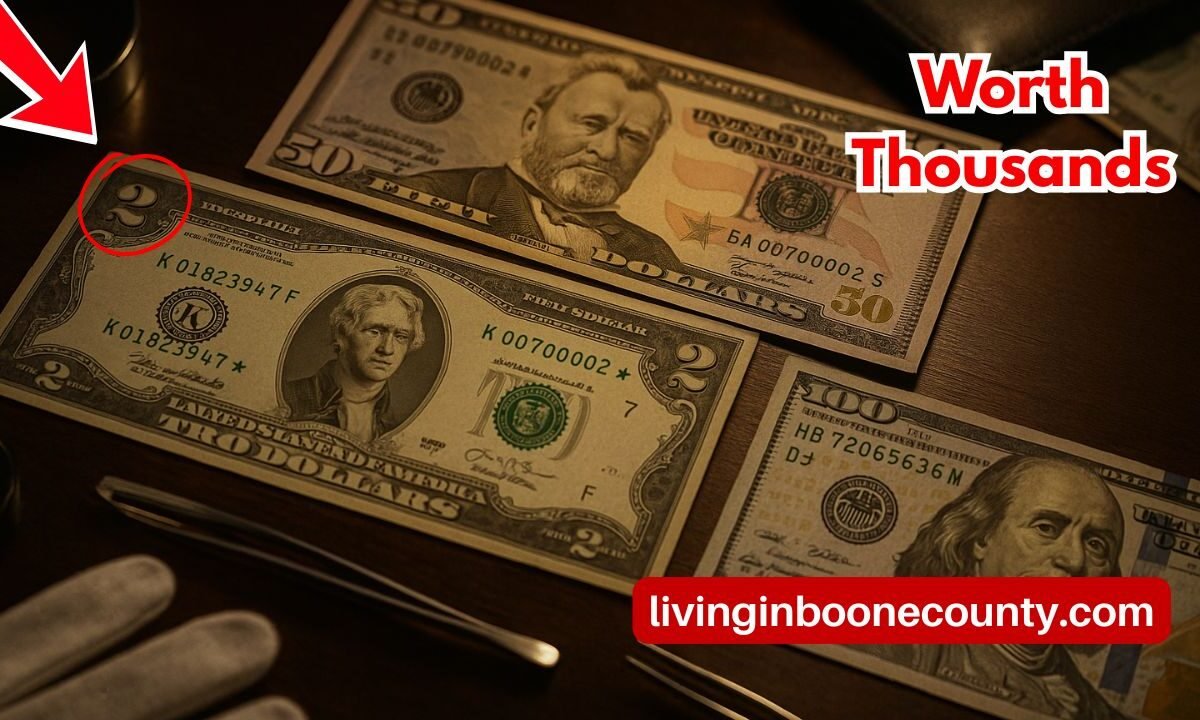Have you ever looked closely at the bills in your wallet and wondered if any of them might be worth more than their face value? Some $2, $50, and $100 bills are rare and highly collectible.
Differences in printing, unique serial numbers, or errors can make a regular bill worth hundreds or even thousands of dollars. Even bills that look normal could be hidden treasures for collectors.
Most Valuable $2 Bills
While a $2 bill normally just equals two dollars, some versions are much more valuable. Collectors pay special attention to bills with star notes, red seals, or unusual serial numbers.
- 1928 Series $2 Bill: This is one of the earliest small-size $2 bills and is very rare, especially with red seals. A circulated bill can be worth anywhere from a few dollars up to $175, while an uncirculated, perfect bill may fetch up to $20,000.
- 1953 Red Seal $2 Bill: This series is less rare but still valuable. Circulated bills in good condition are worth $3 to $6. Uncirculated bills start around $12. Star notes from this series can be worth $15 to $18.
- 1976 Bicentennial $2 Bill: Printed to celebrate America’s Bicentennial, some bills with unique serial numbers or printing errors can be worth $5 to over $500.
- 1995 Star Note $2 Bill: Star notes are replacement bills and are highly collectible. While most are worth $2, some uncirculated examples are valued up to $500.
Most Valuable $50 Bills
$50 bills can also be valuable if they are old or have unique features. Collectors especially look for star notes, unusual serial numbers, and crisp condition.
- 1934 Series $50 Bill: Older series often have more value. Extremely fine notes from 1934 can sell for $65 to $75.
- 1929 Brown Seal $50 Bill: The brown seal and year make this bill unique. If still in good condition, it could be worth $75 to $100.
- 1985 $50 Star Note: Replacement star notes from 1985 are rare. Uncirculated bills may be worth $60 to $398, while circulated notes can go for $75 to $85.
Most Valuable $100 Bills
Even $100 bills can have hidden value beyond their face value, especially older series or star notes.
- 1966 Red Seal $100 Bill: This series is rare and can be valuable, especially if uncirculated. Estimates range from $135 to $169.
- 1996 $100 Star Note: Star notes in this series are uncommon. While most are worth $100, some can be valued between $150 and $350.
- 2009A Series $100 Bill: Later series are usually less valuable, but bills with unique serial numbers or star notes may be worth up to $1,175.
How to Identify Valuable Bills
- Look for star notes: A small star at the end of the serial number indicates a replacement bill.
- Check the seal color: Red or brown seals usually indicate older and more collectible bills.
- Observe the serial numbers: Low, repeating, or unusual numbers can increase a bill’s value.
- Condition matters: Uncirculated or crisp bills are worth more than worn bills.
Rare $2, $50, and $100 bills can be exciting finds and may be worth far more than their face value. The rarity, condition, and historical background of a bill determine its value. For collectors or anyone interested in numismatics, checking your wallet for unusual bills could lead to a valuable discovery.
Always consult a professional currency dealer for a proper assessment before selling. While not every bill is a hidden treasure, you might have a small fortune in your pocket without even knowing it.
FAQs
How can I tell if my bill is valuable?
Check for star notes, unique serial numbers, red or brown seals, and uncirculated condition.
Can I spend a rare bill normally?
Yes, all bills are legal tender, but selling it to a collector could be much more profitable.
Where should I sell a rare bill?
Use trusted currency dealers or auction houses to get the best value and ensure safety.

